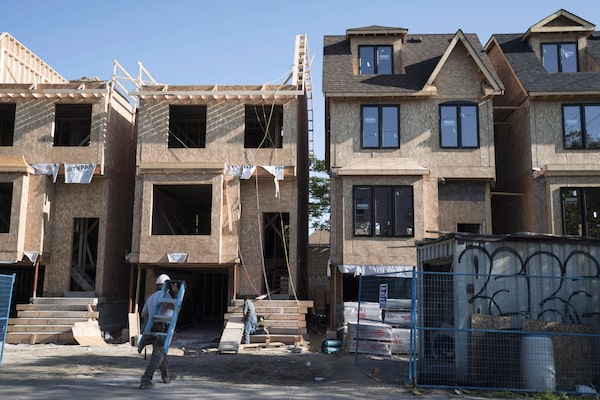Dr. Carolyn Whitzman is a housing and social policy researcher who acts as the Expert Advisor to the Housing Assessment Resource Tools (HART) project, based at UBC. HART analyses census data by income category, household size and priority populations, to provide advice to all levels of Canadian government.

Houses under construction in Toronto in 2015. It's becoming ever more clear that the market-rent-based definition of affordable housing will not alleviate homelessness or inadequate housing.GRAEME ROY/The Canadian Press
The City of Toronto’s “new” definition of affordable-housing rent, which is geared to 30 per cent of pre-tax household income, is being appealed at the provincial level by developers. In reality, the city is simply returning to the standard definition of affordable housing as a proportion of household income, used for close to a century in Canadian housing policy.
It is the definition used by Statistics Canada and the Canada Mortgage and Housing Corp. (CMHC), B.C. and Quebec – the only two provinces that maintained substantive housing agencies after the federal government downloaded responsibility in the 1990s – and Edmonton and Calgary. It is used by the City of Vancouver to monitor its income-based targets. It is the only definition that is consistent with Canadian human rights-based housing law.
Yet, most programs at the federal and provincial level, including those in Ontario’s new More Homes Built Faster law, still use the more recent market-based definition of affordable housing. How has this definition – usually 80 per cent of average rent in an area – taken hold? And what are the implications of restoring a standardized definition of affordable housing based on income?
The origin of the rent-geared-to-income formula – or RGI – lies in Second World War housing supply shortages and consequent rent gouging by landlords. In 1944, national rent controls were established. The federal government also created a commission on postwar housing and community planning, known as the Curtis Commission, after the lead author. The commission’s report set a target of 606,000 new homes to be built between 1946-56, with a third to be public housing aimed at low-income households, a third rental housing aimed at middle-income households and a third market ownership aimed at high-income households.
At that time, rent was commonly considered “a day’s work in a week” i.e. 20 per cent of income. An ambitious Wartime Homes rental program began, leading to over a million homes being built by 1960, but most were sold off to the tenants over time. One wartime home in Toronto’s Don Mills neighbourhood, initially bought for $6,000 (about three times an average income worker’s annual salary at the time), sold substantially unimproved in 2021 for $2-million, 24 times median household income in the city.
Fast forward 80 years. The National Housing Strategy has two targets: to reduce core housing need by 530,000 households by 2028 and to eradicate homelessness by 2030. A household is in core housing need if they are paying more than 30 per cent of pre-tax income on housing costs (rent or mortgage, including utility costs) and/or is overcrowded or in uninhabitable housing, and it cannot access alternative local market housing that meets all three standards.
However, the CMHC’s big-ticket housing programs – the National Co-investment Fund and the Rental Construction Finance Initiative – do not use their own definition of affordable housing. And so, unsurprisingly, numerous studies have found that the so-called “affordable housing” being built with federal funding does not help those households in core housing heed. Their median income is $23,227. They can afford a maximum $580-a-month rent. Nearly 80 per cent have a total pre-tax household income below $35,808, equivalent to a $895-a-month rent.
Average market rent in Vancouver for a two-bedroom home is $1,720, and 80 per cent of average market rent is $1,376. That means only 4 per cent of rents produced by the Rental Construction Finance Initiative would be affordable to a low-income single mother, the most common household in core housing need.
So where does the market-rent approach to affordable housing come from? In the early 1990s, the federal government downloaded responsibility for affordable housing to provinces, most of whom downloaded it to municipalities. For the next three decades, private development was assumed to be the best – and only – way to produce affordable housing. Governments subsidized them through grants, financing, and housing allowances to provide slightly-below-market rents for a limited period of time – 10 or 20 years. It is hardly surprising that homelessness began steadily increasing in Canada as the construction of social RGI homes ended.
Today, as large investors buy up Canada’s remaining market-affordable housing stock and average rents increase with surging inflation, it becomes ever more clear that the market-rent-based definition of affordable housing will not alleviate homelessness or inadequate housing.
All governments in Canada must have a common definition, reflected in affordable housing programs that provide adequate upfront grants and low-cost financing to social developers who can maintain affordable housing in perpetuity. That is the only way that low- and moderate-income households will find the homes they need at a price they can afford.